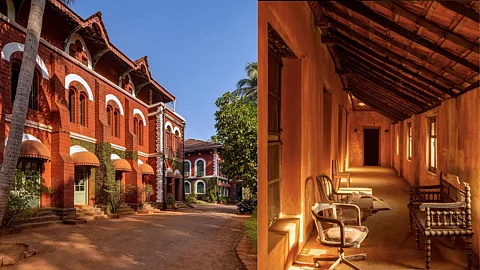How A Boutique Homestay In Sawantwadi Is Reviving Local Craftsmanship With A Royal Touch
The morphogenesis of a brick walled palace into a boutique art hotel by architect Vijay Gajbar and restorationist Abhishek Bhatnagar is nothing short of cultural revivalism. “For us, this has always been a passion project," confesses Lakham Sawant, the yuvraj (scion) of reigning Sawant Bhonsle family who have been custodians of this Konkan princely state since 1627. "Not only did we want to preserve Sawantwadi’s heritage, we also wanted to ensure that guests are welcomed as part of our family." Reintroducing old, cobwebbed queenly quarters to the miracle of sunlight and fresh air, the wing of Taisaheb Wada now hosts six suites open to visitors who would like to spend a night or two at this luxury homestay.
Barely an hour's drive away from Goa, the coastal oasis of Sawantwadi is located in the Sindhudurg district of Maharashtra and its ancestral seat of power is spreadeagled across six and a half acres, overlooking the iconic Moti Talav (lake) and commanding a panoramic view of the Juna Kot (older palace) atop Narendra Hill. The descendants of this once formidable dynasty, Lakham and his wife Shraddha Sawant Bhonsle bring their New York culinary skills to the forefront along with their unceasing reverence for the tortuous legacy of local craftsmanship to create a bespoke experience that transcends the limits of hospitality.
Bereft of any marble and hewn from endemic red laterite stone in the 18th century, the Sawantwadi Palace itself is an architectural eulogy to Indian workmanship and undulating English arches, still standing undaunted by the tremors of colonial history. The durbar hall (originally designed by Lieutenant-Colonel E. P. Cambier) serves as a makeshift studio space for local chitrakars (artists) who spend hours every day assiduously reproducing 10 avatars of Lord Vishnu upon the courtly playing cards that comprise the Mughal-inspired legacy of ganjifa. The vivacious designs painted on these decks inform the interiors of each of the six suites, stacked in the favour of Vishnu's incarnations, manifesting as decorative motifs upon doorknobs and mirror frames.
Whether you are swigging an Elderflower Highball concocted by the in-house mixologists or gorging on the Malvani Thali plated with extravagance by the chef-prince Lakham, a panoply of sensorial adventures awaits your uninitiated taste buds. Irrigating her love of Asian cuisine like Cold Peanut Soba Noodles or Kimchi Fried Rice with a playful dribble of Sawantwadi homegrown ingredients, yuvrani Shraddha ensures that the tasting menus for dinner are an amalgamation of diverse gastronomic influences. A special mention goes to the stuffed nachini crepes that folds finger millet batter around an inspired filling of cream cheese, house-made ricotta and avocados to make for a genre-defying breakfast meal.
The two-storied estate has a curiously inviting allure with its Mangalorean tiled roofs, carved Burmese teak pillars and medieval temple furniture reupholstered by carpenters from the family's own line of Sawantwadi Woodworks. Quaint, vernacular episodes of jharokha windows, haveli style verandahs peeping into a central courtyard and archaic turrets lend the space a nostalgic magnificence that will stay with you forever. If you were to venture out of this living museum, you would find more instances of native artistry in the Chitari Gali that clambers up from Moti Talav and is the perfect showcase for pangara wooden toys meant for Brahmin bridal trousseaus. You can also head to the unassuming village of Pinguli that is the heartland of Chitrakathi paintings and string puppetry passed down for centuries among the Thakkar adivasi community.
Despite being the cynosure of indigenous handiwork, the past three decades or so have seen a whittling down of artisans still practising their traditional livelihoods in India by a disheartening 30 per cent, according to the United Nations. This can be attributed largely to the lack of a commercial ecosystem wherein the correct market value can benefit all stakeholders while also competing with the dangers of mass production. Say what you will about princely states of yore but the royal family of Sawantwadi has not been remiss in patronising their Chitari wooden toys, lacquerware and Ganjifa art even during the recent pandemic.
To stay at the Sawantwadi Palace is like listening to a folk song, the words to which may elude you but the sentiment you will recognise instantly.


